Last year, one of the first posts I wrote for the TL site was as a summary of Kaltura, Inc’s whitepaper on the state of video in the education space. Kaltura is back at it again in 2016, this time with a much more in-depth, 45-page report. While I think it’s important to bear in mind…Continue Reading Report – Interactive Video in Education 2016
Report – Interactive Video in Education 2016

